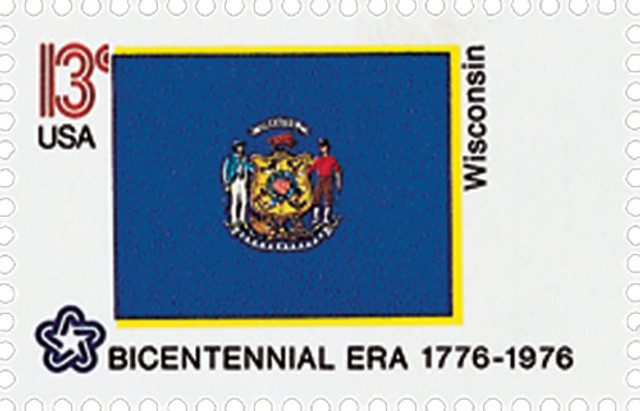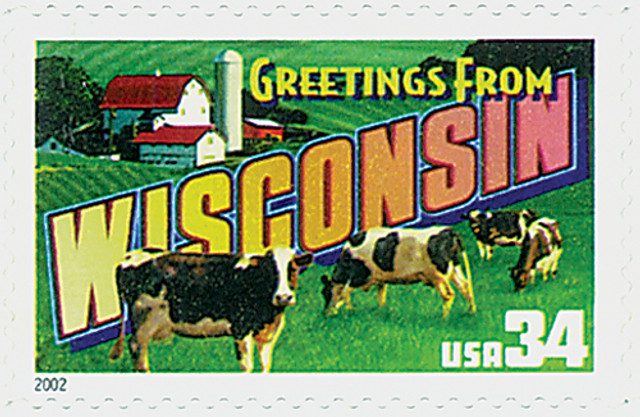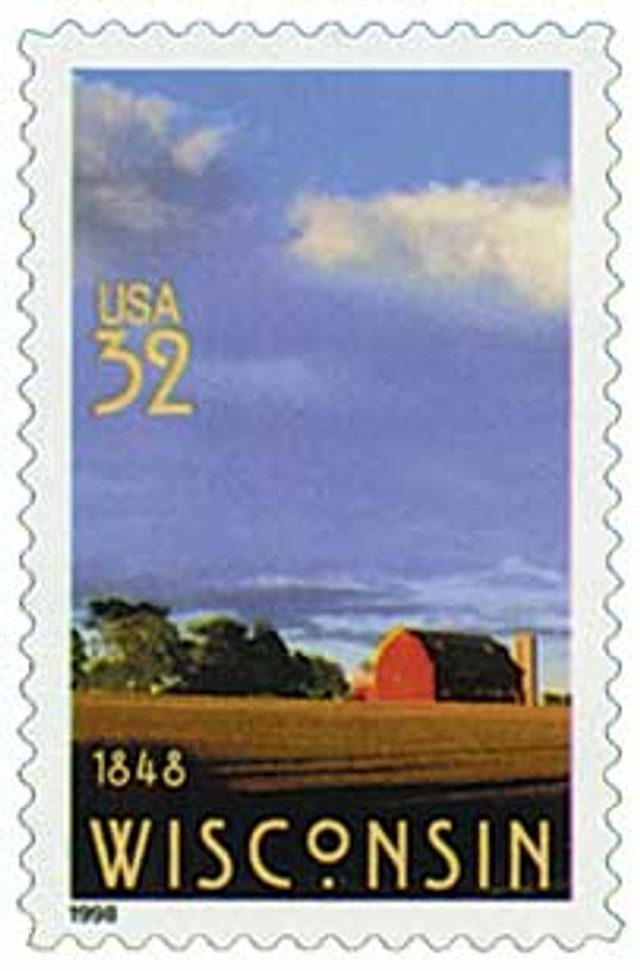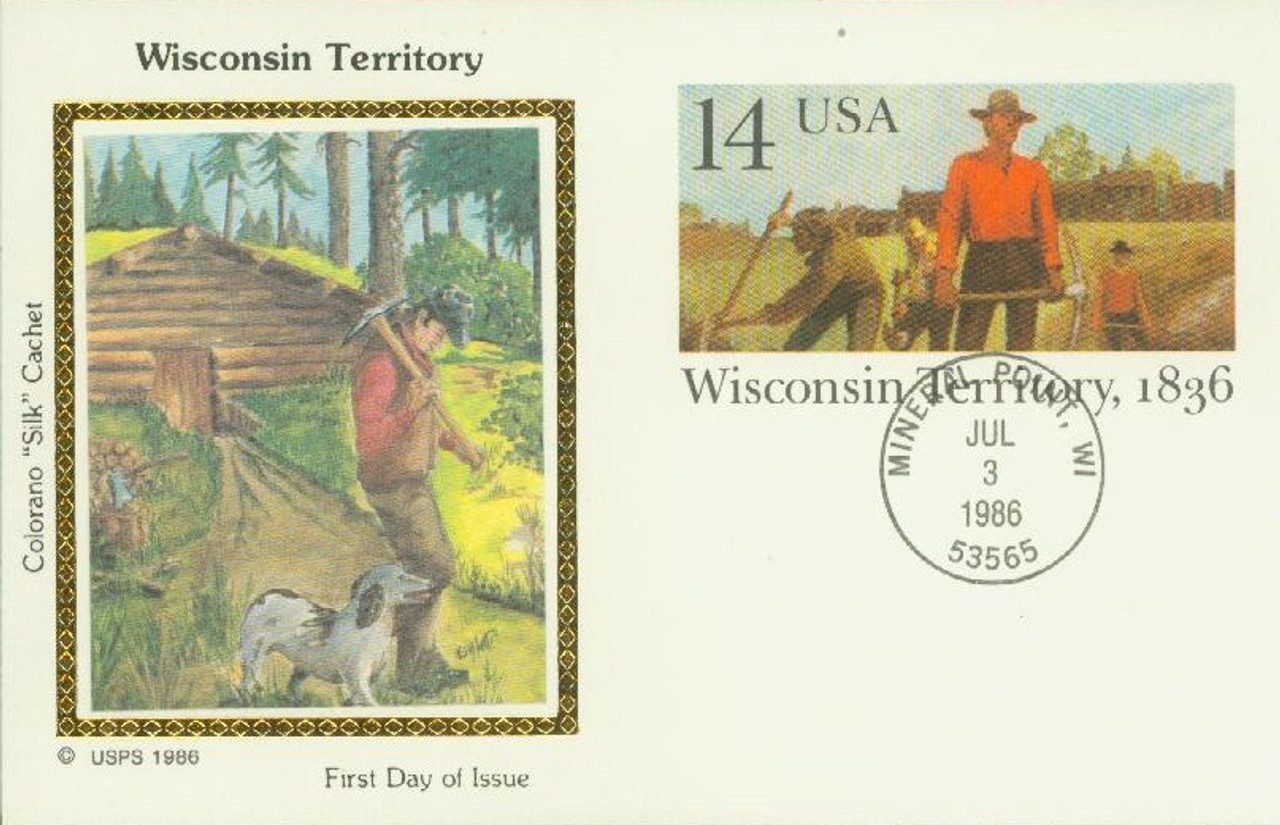
On May 29, 1848, Wisconsin was admitted as America’s 30th state.
When the first European explorers arrived in Wisconsin during the early 1600s, the main Indian tribes were the Winnebago, Dakota, and Menominee. Within the next 100 years, many other Native American groups moved into the region after being pushed from their lands in the East by whites – or to escape the warring Iroquois League. These tribes included the Sauk, Fox, Ottawa, Kickapoo, Huron, Miami, Illinois, and Potawatomi.
The French explorer Jean Nicolet became the first white person to set foot in Wisconsin in 1634. Nicolet was searching for a water route to China, and believed he may have reached that distant country when he landed on the shore of present-day Green Bay. The explorer came ashore dressed in a colorful robe and firing two pistols, making quite an entrance, but was disappointed when he was greeted by Winnebago Indians and not Chinese officials. Nicolet then returned to New France, today’s Quebec, reporting that America was much larger than anyone had guessed.

Around 25 years later, on a mission to acquire furs, Pierre Esprit Radisson and Médard Chouart, Sieur des Groseilliers, explored Wisconsin. In 1660, Father René Ménard became the first missionary to reach Wisconsin. Ménard established a mission near today’s Ashland. Father Claude Jean Allouez came to the area in 1665 and built several missions. Assisted by Father Louis André, he established a mission at today’s De Pere.
The French had long maintained friendly relations with the Indians in Wisconsin. However, in 1712, a war broke out between the French and the Fox Indians over control of the Fox and Wisconsin Rivers. The French won the war in 1740, but had severely weakened their defenses and damaged their relations with other Native American tribes in the area. The French and Indian War began in 1754. This conflict between France and Great Britain and their Indian allies ended in a British victory with the Treaty of Paris in 1783. As a result, France lost Canada and nearly all of its possessions east of the Mississippi River, including Wisconsin.

With the Quebec Act of 1774, the British made Wisconsin a part of Quebec. This angered Americans and helped to spark the American Revolution in 1775. That war ended with the 1783 Treaty of Paris, which gave all the land east of the Mississippi and south of the Great Lakes, which included Wisconsin, to the United States.
From 1800 to 1809, Wisconsin was part of the Indiana Territory, from 1809 to 1818 it was part of the Illinois Territory, and from 1818 to 1836 it was part of the Michigan Territory. During the 1820s, settlers poured into the southern part of the state. Lead was discovered, and a demand for lead to use in paint and shot made mining more profitable. Many miners lived in shelters that were dug into the sides of hills – earning them the nickname “badgers.” This name came to be used for all Wisconsinites.
The Black Hawk War of 1832 was fought in Wisconsin. The Sauk Indians had been pushed from their land in northwestern Illinois across the Mississippi River to Iowa. In April 1832, Sauk Chief Black Hawk led 1,000 of his people back to their homeland to plant corn. When Black Hawk crossed the Mississippi, the white settlers panicked, and volunteer militia and regular troops were called into action. Black Hawk retreated to Wisconsin, and several fierce battles were fought. When the war finally ended in August, only about 150 Sauk Indians were left alive.
On April 20, 1836, Congress established the Wisconsin Territory. Madison became the capital of the territory, and Henry Dodge became the territorial governor. The Wisconsin Territory included part of present-day Minnesota, Iowa, and North and South Dakota. When the Iowa Territory was created in 1838, the Mississippi River became Wisconsin’s western border.
On May 29, 1848, Wisconsin joined the Union. At that time, its borders were established as they are today. The state’s population was growing fast. In 1840, 30,945 white settlers lived in Wisconsin. By 1850, the number had grown to 305,391. These settlers came from all over the U.S. and from various other nations, as well.

The majority of Wisconsinites were opposed to slavery. When the Kansas-Nebraska Bill (designed to allow new territories to decide whether to allow slavery or not) was introduced to Congress, a large protest was held in Ripon in February 1854. This protest contributed to the creation of the Republican Party, which quickly became powerful in the North. Republicans dominated the state’s government for the next 100 years.
During the American Civil War, Wisconsin soldiers served with distinction. One of the Union’s outstanding fighting units, the Iron Brigade, consisted largely of Wisconsin regiments. At various times during the war, Wisconsin generals commanded the Iron Brigade.
In 1871, the state was struck by the worst natural disaster in its history. The summer and fall of 1871 were extremely dry. Many small forest fires started during that time. On October 8, the northeastern portion of the state erupted in flames. The fire devastated the town of Peshtigo and several villages. About 1,200 people were killed – 900 more people than were killed in the more famous Great Chicago Fire that occurred on the same night. The fire also destroyed more than $5 million in property.
In 1900, Robert M. La Follette, Sr., a lawyer and former U.S. Congressman, was elected governor of Wisconsin. La Follette called his political program “Progressivism.” This program included the “Wisconsin Idea” – the idea that the state should be served by its best minds, like professors and other experts. Under La Follette, such measures as inheritance tax, railroad property tax, regulation of railroads, and primary law were enacted. La Follette’s eldest and youngest sons also served Wisconsin; the elder as senator and the younger as governor.
After World War II, agriculture began to decline in Wisconsin, and manufacturing became more important economically. The state’s farmers were hurt by foreign competition and changes in the American diet. From 1951 to 1969, the number of dairy farms fell from 132,000 to 63,000.
During the mid-1900s, Wisconsin greatly expanded its educational facilities. The University of Wisconsin opened 15 new branches between 1956 and 1970. Problems facing the state include the high cost of education, water pollution, and lack of sufficient public recreation lands.
Discover what else happened on This Day in History.



ERROR!
The Treaty of Paris of 1783 ended the Revolutionary War.
The Treaty of Paris of 1763 ended the French and Indian War.
i liek to share with all you embed for the job is expected for a very a stamp the company do bsead the haestryiin in each stamphow to lookis good in good in good
Many people aren’t aware that the republican party started in Wisconsin and was started because of it’s anti slavery stand. Lincoln, from neighboring Illinois, was an early adherent of the newly founded republican party.